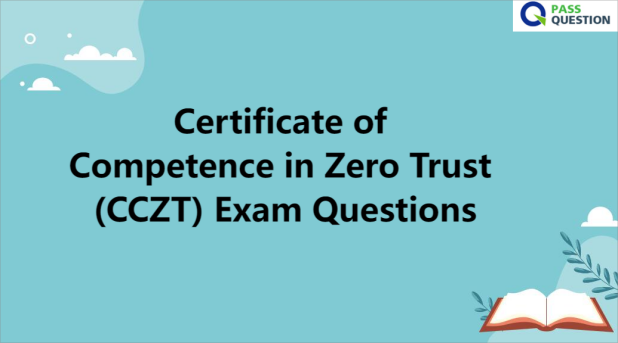Certificate of Competence in Zero Trust (CCZT) Exam Questions
The Certificate of Competence in Zero Trust (CCZT) offered by the Cloud Security Alliance (CSA) provides professionals with a deep and thorough understanding of Zero Trust architecture, planning, and implementation. To enhance your preparation for the CCZT Certification exam, PassQuestion offers a wide range of Certificate of Competence in Zero Trust (CCZT) Exam Questions that cover all the objectives tested in the exam. By utilizing these Certificate of Competence in Zero Trust (CCZT) Exam Questions, you can boost your confidence and increase your chances of success in the CCZT exam.

Certificate of Competence in Zero Trust (CCZT)
CSA developed the Certificate of Competence in Zero Trust (CCZT) to offer widely accepted best practices. Introduced in 2023, the CCZT is built upon the fundamental principles outlined in CSA's Zero Trust Training (ZTT). These principles encompass an introduction to Zero Trust Architecture, Zero Trust Planning, and Zero Trust Implementation. The certificate grants a comprehensive comprehension of Zero Trust architecture, its constituents, and its operations. Acquiring the CCZT is crucial for security experts aspiring to progress in their careers and for organizations that need to uphold robust security postures. As Zero Trust solidifies its position as the future of information security, a Zero Trust based approach will inevitably become obligatory for organizations and a necessary skill for professionals.
The CCZT exam is an online exam that can be taken with open-book access. It consists of 60 multiple-choice questions selected from the topics covered in the CCZT course. The exam must be completed within 90 minutes. To purchase the exam, it costs $175 and allows for two attempts within a two-year period. To pass the exam, a minimum score of 80% is required. Currently, the CCZT exam is available only in the English language.
Advantages of Certificate of Competence in Zero Trust (CCZT) Certification
The Certificate of Competence in Zero Trust (CCZT) provides several significant benefits for individuals and organizations who obtain it. These advantages include the following:
1. Building a competent workforce and fostering individual development: By obtaining the CCZT certification, professionals can demonstrate their expertise and commitment to zero trust excellence. This certification serves as evidence of their knowledge and skills, making them valuable assets to their organizations. Additionally, individuals who pursue the CCZT can further develop their capabilities and stay up-to-date with the latest advancements in zero trust architecture.
2. Gaining an in-depth understanding of Zero Trust: The CCZT program offers a comprehensive curriculum that covers various aspects of Zero Trust, including architecture, planning, and implementation. By completing this certification, individuals acquire a thorough knowledge of the principles and components of Zero Trust, enabling them to implement robust security measures and create secure systems. This understanding is crucial in today's rapidly evolving cybersecurity landscape.
3. Keeping up with innovation in cloud security: As technology continues to advance, cloud security challenges and vulnerabilities also evolve. The CCZT certification equips professionals with the skills and knowledge necessary to tackle these evolving threats using a Zero Trust approach. By staying updated with the latest innovations and best practices, CCZT-certified individuals can effectively address cloud security concerns and ensure the protection of critical systems and data.
CCZT Exam Topics
The CCZT evaluates an individual's knowledge and expertise in various key areas related to Zero Trust security. Successfully passing the exam signifies proficiency in the following essential topics:
- Zero Trust Foundational Concepts
- Zero Trust Architecture
- Software Defined Perimeter
- NIST and CISA Best Practices
- Zero Trust Planning
- Zero Trust Implementation
View Online Certificate of Competence in Zero Trust (CCZT) Free Questions
1. Which of the following is a potential outcome of an effective ZT implementation?
ARegular vulnerability scanning
BA comprehensive catalogue of all transactions, dependencies, and
services with associated IDs
CDeployment of traditional firewall solutions
DAdoption of biometric authentication
Answer: B
2. When planning for ZT implementation, who will determine valid users, roles, and privileges for accessing data as part of data governance?
A.IT teams
B.Application owners
C.Asset owners
D.Compliance officers
Answer: C
3. According to NIST, what are the key mechanisms for defining,managing, and enforcing policies in a ZTA?
A.Policy decision point (PDP), policy enforcement point (PEP), and policy information point (PIP)
B.Data access policy, public key infrastructure (PKI), and identity and access management (IAM)
C.Control plane, data plane, and application plane
D.Policy engine (PE), policy administrator (PA), and policy broker (PB)
Answer: A
4. ZT project implementation requires prioritization as part of the overall ZT project planning activities. One area to consider is______
A.prioritization based on risks
B.prioritization based on budget
C.prioritization based on management support
D.prioritization based on milestones
Answer: A
5. When planning for a ZTA, a critical product of the gap analysis process is______
A.a responsible, accountable, consulted, and informed (RACI) chart and communication plan
B.supporting data for the project business case
C.the implementation's requirements
D.a report on impacted identity and access management (IAM) infrastructure
Answer: C
6. During the monitoring and analytics phase of ZT transaction flows, organizations should collect statistics and profile the behavior of transactions. What does this support in the ZTA?
A.Creating firewall policies to protect data in motion
B.A continuous assessment of all transactions
C.Feeding transaction logs into a log monitoring engine
D.The monitoring of relevant data in critical areas
Answer: B
- TOP 50 Exam Questions
-
Exam
All copyrights reserved 2025 PassQuestion NETWORK CO.,LIMITED. All Rights Reserved.

